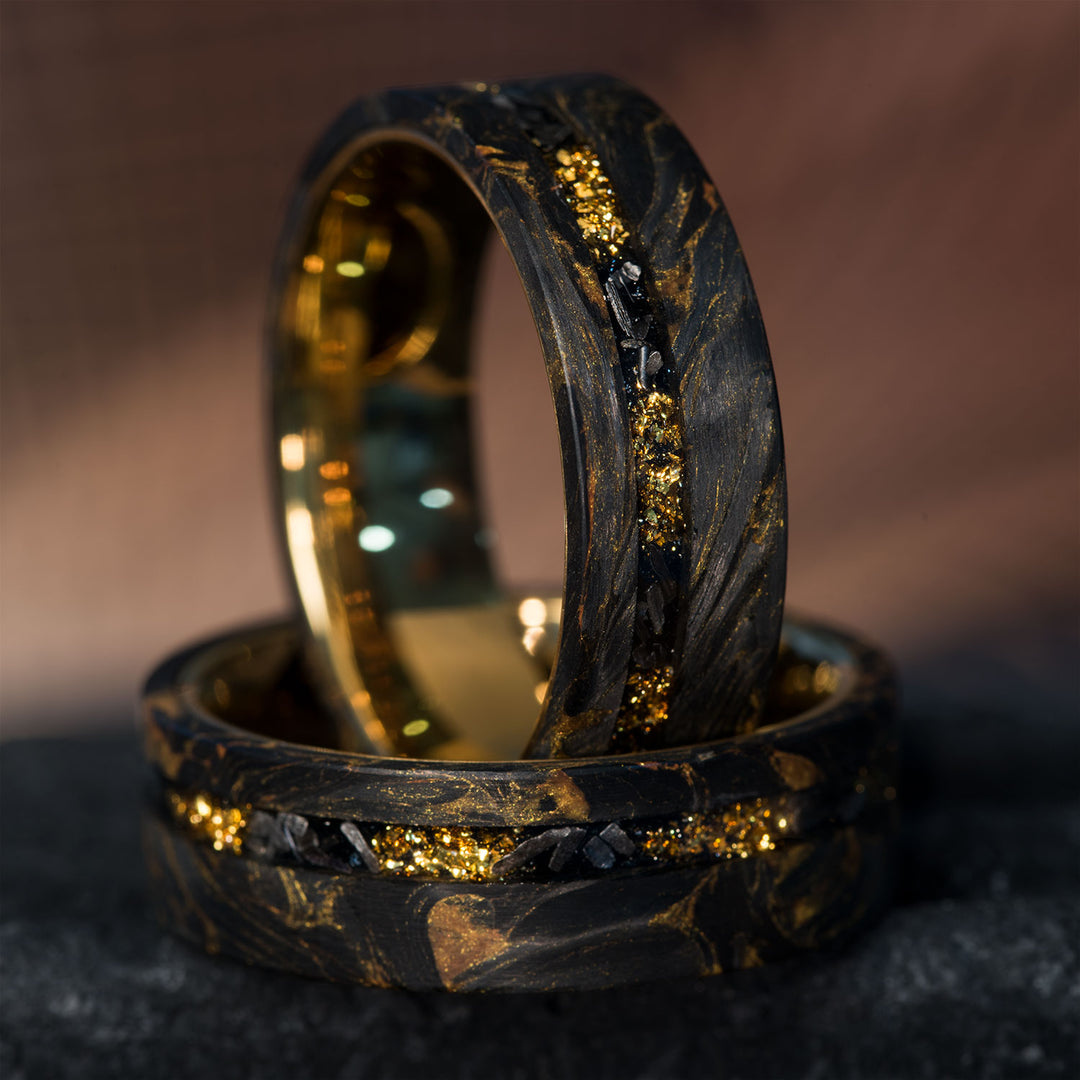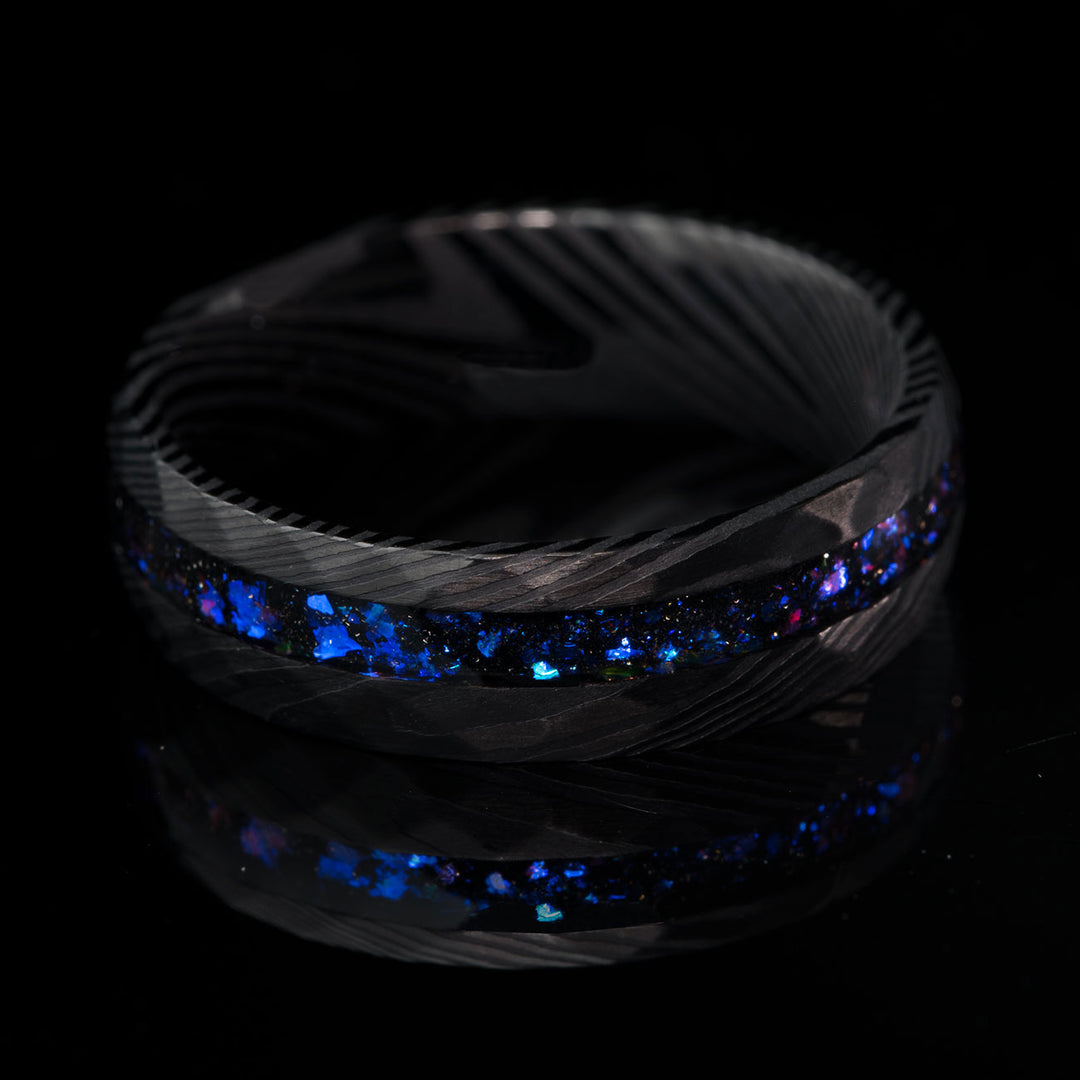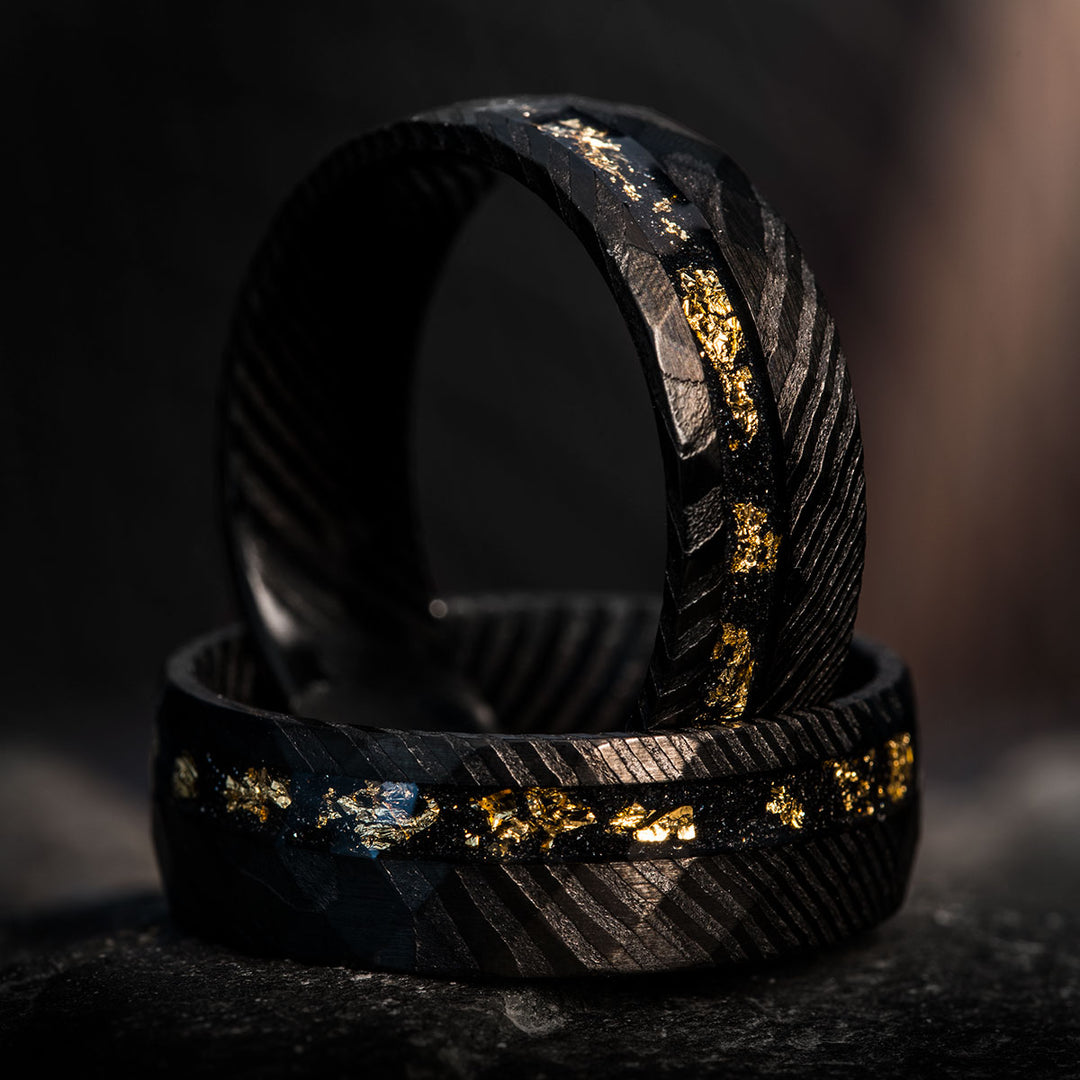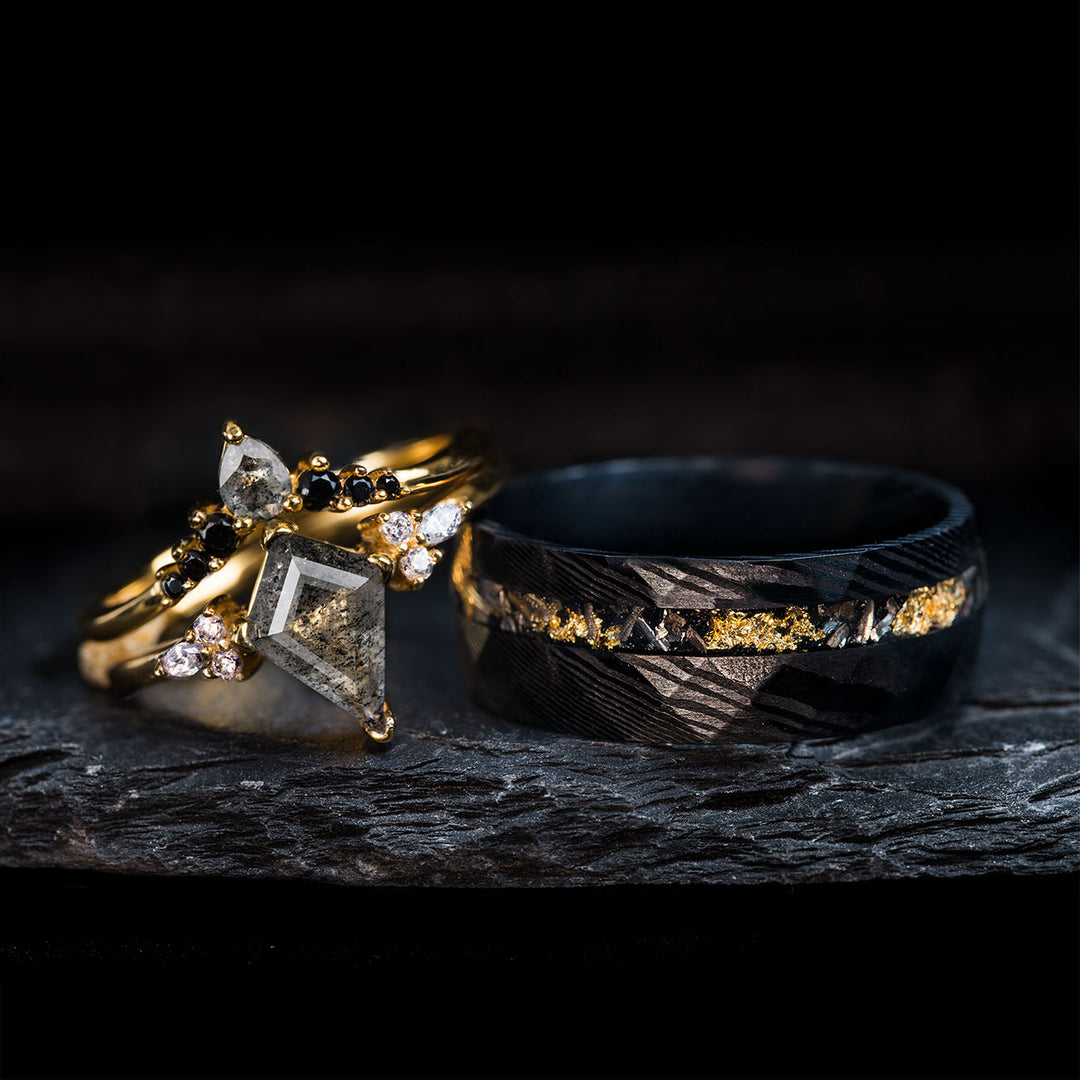Want a wedding ring with a history of billions of years? Meteorite rings are made from real bits of space rock that have fallen to Earth. Every single one has a different pattern, so they're never identical. For a couple who wishes for a ring as unique and amazing as their own love story, to wear a bit of the universe is astounding.
What is a Meteorite Ring?

A meteorite ring is a wedding band made with a slice of a real meteorite—a rock that has traveled through space and landed on Earth. When sliced open, the meteorite reveals a striking, natural pattern, which means that no two meteorite rings are ever exactly alike. You're wearing a truly one-of-a-kind piece of the cosmos.
The Origin Story: From Space to Your Finger
The meteorites used for jewelry are mostly iron that was once part of an asteroid's core. While floating in the vacuum of space, this iron-nickel metal cooled down incredibly slowly over millions of years. This super-slow cooling process created a unique, crisscrossing metallic pattern inside the rock, known as a Widmanstätten pattern. This design is impossible to recreate on Earth, and it's what gives a meteorite ring its signature, mesmerizing look.
Types of Meteorites Used in Rings
Jewelers prefer a few specific meteorites for their beauty and stability. The three you'll see most often are:
- Gibeon Meteorite: Found in Namibia, Gibeon is a very popular choice for rings. It's known for having a sharp, classic pattern that really stands out. Its high nickel content also makes it naturally more resistant to rust, so it's a durable option.
- Muonionalusta Meteorite: Discovered in Sweden, this meteorite has a beautiful, fine-etched pattern and is often treated by jewelers to protect it and make it even more durable for everyday wear.
- Seymchan Meteorite: From Russia, Seymchan offers a unique blend, sometimes featuring olivine crystals (making it a pallasite) within its metallic matrix, adding a splash of color.
Pros and Cons of Meteorite Wedding Rings
Like any major investment, there are also pros and cons to a meteorite wedding ring. Understanding these will allow you to determine whether this cosmic option is right for you.
Advantages: A Universe of Positives
- Unparalleled Uniqueness: No two meteorite wedding bands are the same. The Widmanstätten patterns are unique to each meteorite slice, so your ring is truly personal. This makes a bold statement about your one-of-a-kind love.
- Deep Symbolism: Wearing a piece of something billions of years old, something that has traveled across the universe, is of great significance. It signifies eternal love, strength, and a bond that transcends earthly relationships.
- Conversation Starter: Get ready for questions and compliments! A meteorite wedding band is a unique piece that will draw attention and ignite interesting conversations.
- Durability (with care): While meteorite itself needs care, when properly set and combined with durable metals, these rings can last a lifetime.
Disadvantages: Things to Consider
- Susceptibility to Rust: Meteorites, especially iron meteorites, contain iron, which tends to rust if not properly maintained. This is the largest worry for most buyers. Jewelers typically treat the meteorite or blend it with rust-free metals to neutralize this risk.
- Maintenance Needs: To avoid rust and make it look its best, a meteorite ring will require a bit more attention than a solid platinum or gold band. This means keeping it dry and oiling it occasionally.
- Resizing Issues: Because of the meteorite nature, it is either hard or impossible to resize a meteorite wedding ring without causing damage to the meteorite inlay. Jewelers often offer ring exchange services to ensure you have a suitable wedding ring.
- Price: Due to their rarity and the skill with which they are crafted, meteorite wedding rings can be pricier than ordinary rings at times.
What Types of Meteorite Wedding Rings Can You Find?
Jewelers get very creative by mixing meteorite with other metals, creating designs that are both beautiful and durable.

Inlay vs. Solid Meteorite
- Meteorite Inlay Rings: Most meteorite rings you'll find are inlays. This is where a slice of meteorite is set into a channel inside a stronger metal band, like titanium, tungsten, or gold. This approach protects the more delicate meteorite from daily wear while still showing off its incredible pattern.
- Solid Meteorite Rings: A ring made entirely from meteorite is a bold statement, but it's less common. Because meteorite is mostly iron, it can be prone to rust and damage. These rings need a special protective coating to keep them in good shape.
Meteorite's Pairing with Various Metals
The metal you choose for the meteorite band plays a big role in the ring's look and durability.
- Titanium: This metal is very popular because it's super lightweight but tough, and it's great for sensitive skin. Its modern, grayish color creates a nice contrast with the meteorite.
- Tungsten: Tungsten is extremely hard and resists scratches like almost nothing else. It has a heavier feel on the hand and a darker, polished look that provides a perfect frame for the inlay, create a classic tungsten meteorite ring.
- Gold (Yellow, White, Rose): For a more traditional feel, tungsten band with gold leaf and meteorite is a great choice. It gives the ring a classic, warm look. Rose gold offers a unique color, while white gold blends smoothly with the meteorite's metallic tones.
- Platinum: A top-of-the-line choice, platinum is naturally silvery-white, very durable, and won't cause skin irritation. It provides a bright, sophisticated frame for the meteorite.
- Damascus Steel: For a ring with two amazing patterns, you can pair meteorite with Damascus steel. The mix of the space rock's design and the steel's unique wavy lines is incredible, creating a true showstopper Black Damascus Steel Meteorite Ring.

Adding Your Personal Touch
You can also add other details to make your ring even more special.
- Add Gems: You can have small diamonds or other gemstones set into the metal part of the band for a little extra sparkle.
- Get it Engraved: Most jewelers can engrave a message, name, or date on the inside of the band to make it completely unique to you.
- Pick Profile and Finish: You can also choose the ring's shape (flat, domed, or comfort fit) and finish (polished, brushed, or satin). A polished finish is bright and shiny, while a brushed or satin finish has a softer, matte look.
Is a Meteorite Ring Right for You?
A meteorite ring is an incredible choice, but it's not for everyone. The key is to match its unique look with your lifestyle and what you want in a wedding band.
Consider Your Lifestyle
Are you very active or do you work with your hands a lot? If so, you'll have to be good about taking the ring off during sports, at the gym, or when using chemicals. Meteorite rings also need a little upkeep, like occasional cleaning and oiling, to prevent rust. If you want a piece of jewelry you can wear 24/7 without a second thought, this might not be the best choice. On the other hand, if you love having something that no one else has, this is a perfect fit.
Reflect on Symbolism
For many couples, the real draw is wearing a piece of outer space. It can be a powerful symbol of a love that feels ancient, rare, and connected to something much bigger. If that idea excites you, then the unique story behind your ring will always feel special and personal.
Budget Considerations
Meteorite wedding bands can also differ greatly in price as it depends on the kind of meteorite, the metal that they are being paired with, and the complexity of the design. Plan this into your wedding budget as well. Some are quite affordable, but others, especially custom work or precious metal content mixtures, can be a considerable investment.
How to Care for Your Meteorite Wedding Band
Taking good care of your meteorite wedding band requires some effort to maintain its beauty as the day you first put it on. With proper care, your cosmic treasure will last a lifetime.
- Keep It Dry: This is the most important rule. Always take your ring off before washing your hands, showering, or going swimming. Moisture is the main cause of rust on an iron meteorite.
- Avoid Harsh Chemicals: Take your ring off before you use household cleaners or go in a pool or hot tub. The chemicals in cleaners and chlorine can damage the meteorite's surface.
- Apply a Protective Oil: Every so often, you can rub a tiny amount of mineral oil or a product like Renaissance Wax onto the meteorite with a soft cloth. This creates a thin, protective barrier against moisture.
- Clean It Gently: To clean your ring, use a soft cloth with a little bit of mild soap and warm water. After you've cleaned it, the most important step is to dry it completely right away. Never use harsh brushes or scrubs.
- Store It Properly: When you're not wearing your ring, keep it in a dry place. A jewelry box or a soft pouch is a great option to protect it from both scratches and humidity.
- Let a Jeweler Help: If you ever see a spot of rust, don't worry. A good jeweler can often re-etch the ring to remove the rust and restore its unique pattern.
[[推荐商品1]]
Finding Your Perfect Meteorite Wedding Band
A meteorite wedding band is a bold statement. It's for the couple who wants a ring as unique as their own story. While it does ask for a little extra care to stay looking its best, the benefit is huge. You get to wear an incredible piece of natural history, a beautiful fragment of the cosmos that represents a love that's truly one-of-a-kind.









